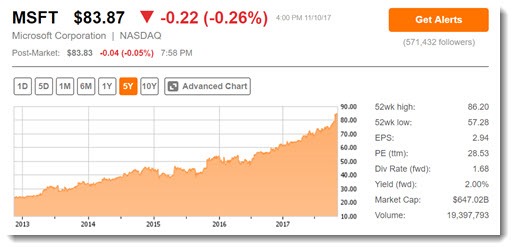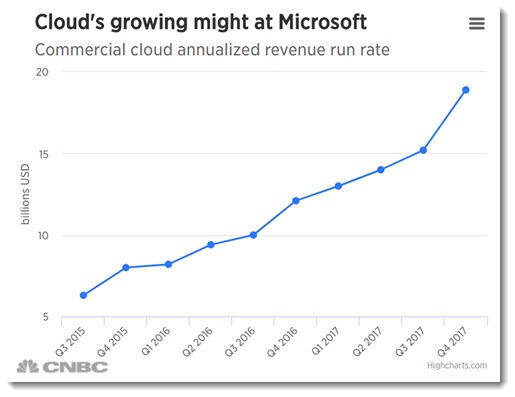
If you’re an individual or small business Windows user, you might have the wrong idea about how Microsoft is doing.
We all tend to generalize from our own experiences. You can be forgiven for thinking that Microsoft’s future is dim when Outlook has just crashed or you’re paralyzed by an unexpected and unwelcome Windows update. Microsoft seems to be the stodgy dinosaur in the Big Five – Apple, Google, Amazon, Facebook, and Microsoft.
The big picture is quite different. When Satya Nadella assumed the post of CEO in January 2014, he started to pivot the entire company toward cloud computing services aimed at large enterprises. The company had already begun to invest in those services but Nadella brought a clear-headed approach that allows Microsoft to thrive in a world that is moving away from Windows computing and the Office programs.
Here’s a picture of Microsoft’s stock price from 2013 to the present.
(Disclaimer: I’m not an investor. I barely understand investing. This isn’t investment advice.)
Microsoft share prices are up 35% in 2017 alone, and have doubled since Nadella became CEO four years ago. It’s an amazing transformation that goes far beyond exuberant stock prices. It reflects a change in the company’s direction that is as significant as its transformation into an Internet-focused company in 1996.
With the benefit of hindsight, let’s take a look at Microsoft’s position in 2014 (and today).
WINDOWS In 2014 PCs had already started their long-term decline – not just in sales but also in their importance in our everyday lives. Windows was then, and continues to be, the most-used computer operating system for individuals and businesses worldwide, but phones have become the primary technology device used by individuals, and Chromebooks are starting to nibble inexorably at Windows’ market share. The effect is most easily seen in Windows 10 market share after a year of free upgrades and heavy promotion. Upgrades happened at a far slower rate than Microsoft hoped and predicted and sales of new computers are down each year. Microsoft is extending the life of Windows with every tool at its disposal and Windows will still be a successful revenue generator for a long time to come but it will never again drive the growth of the company.
OFFICE The Office programs are facing a similar fate. The Office file formats (.DOCX, .XLSX, etc.) have a powerful hold on global businesses but people under 40 do not have the loyalty that will keep them on top forever. New businesses are perfectly comfortable with Google’s online applications. Kids are coming out of schools clutching their Chromebooks with no exposure to the Office programs. Satya Nadella recognized immediately that the best way to extend the lifespan of the Office programs was to make them available on every platform in the universe; one of the first press conferences under his watch was the introduction of Office apps on the iPad, followed by extension of Office apps to Android, iPhones, and the web. Like Windows, however, this is an extension of the lives of products that will inevitably decline in importance.
MOBILE Satya Nadella understood instinctively that Microsoft had missed its opportunity to have a meaningful place in the world of mobile devices. He eventually wrote off the purchase of Nokia as an expensive mistake.
Microsoft has had to deal with the deep consequences of not having a mobile device in your pocket. Apple and Google are both trying to move into home devices – home assistants, lights, thermostats, speakers – that will appeal to you in part because they work so well with your phone. Apple, Google, and Amazon can all leverage your engagement with their ecosystems to sell more services and connected devices. Microsoft is halfheartedly trying to make you think of the Cortana assistant in the same way but has little chance of succeeding. We are too focused on our phones.
To put it in the simplest terms: When it missed the mobile market, Microsoft was left in a position where it cannot count on growth from anything marketed to individuals.
HARDWARE Microsoft is selling a fair number of Surface devices, which are sold as premium devices and hopefully have good profit margins. It’s a decent business but also a competitive one, as the other computer manufacturers come up with more appealing laptops at the same premium price points. I wouldn’t bet on Microsoft staying in the hardware business in the long run. Although it generates a reasonable amount of revenue, it is not driving Microsoft forward.
Nadella took over the CEO position from Steve Ballmer, who had guided Microsoft expertly through antitrust investigations, market crashes, and ups and downs in Windows. Microsoft was perceived as a respected but aging leader whose best days were perhaps behind it. Microsoft stock price was effectively level for his entire tenure. Nadella came in and took important steps to reorganize product groups, heal relationships with competitors like Apple and Google, embrace open source technologies, and strike up partnerships with companies like Salesforce, Box, and Dropbox. Those are all important reasons that the company has rebounded. But Nadella’s most important contribution has been the acceptance of the inevitable fate of Windows and Office, and an understanding of the consequences of not being in the mobile market, which forecloses many other directions aimed at consumers.
Microsoft has pivoted to cloud services for enterprises. It has a chance to play a commanding role in a very profitable long-term area in which it has unique expertise. It is a pivot that is already paying off.
CLOUD SERVICES FOR ENTERPRISES
This chart shows the annualized revenue run rate in billions of dollars for Microsoft commercial cloud services over the last two years.
In the most recent quarter, Microsoft’s cloud computing business exceeded the company’s goal of $20 billion in annualized revenue.
The definition of “cloud computing” is a little fuzzy, but it’s more or less a combination of three things, all aimed primarily at medium and large businesses.
(1) Office 365 is a constantly growing aggregation of services that are successfully creating an ecosystem for businesses. Office 365 started with mailboxes but now includes a dizzying variety of services, from Dynamics 365, an enterprise planning and customer relationship platform, to Microsoft Teams, an office collaboration platform competing with Slack. The name “Office 365” is an umbrella term that covers security services, a multitude of communication and collaboration services, and a long list of other apps and services.
(2) Microsoft began offering Azure, its public cloud-computing platform, in 2010 to compete with Amazon Web Services. Nadella jammed the accelerator pedal down on Azure’s development. Azure is still in second place behind Amazon Web Services but it is successful and growing and there is room for both companies to succeed in that market. Azure is used by ninety percent of Fortune 500 companies to run worldwide networks and provide an endless variety of services. There’s no easy way to summarize what Azure and AWS are doing but it is fair to say that they are the engines running far more of your world than you realize.
(3) Microsoft is in a unique position with large enterprises, however, because those large businesses are already running Windows-based networks from their onsite servers. Microsoft is able to offer hybrid services that tie the existing onsite Windows networks to Azure resources. That gives big companies a crucial method to move their technology online at their own pace and under their control. Amazon Web Services is easy for brand new companies to set up, but more difficult for existing large companies to integrate with. That’s an opportunity for Microsoft. In Microsoft’s most recent earnings call, Nadella drew particular attention to Microsoft’s strength in hybrid connections between on-premise and cloud computing. It will be a critical driver of Microsoft’s growth going forward.
Nothing is assured for Microsoft. This pivot is in its early stages and Google and Amazon are not sitting still. Artificial intelligence will be a disruptive force soon; Microsoft has invested heavily in AI research and is starting to incorporate it into its Azure services, but it will have to execute nimbly to keep up in this fast-moving world.
For today, just don’t be too quick to think Microsoft is suffering when Windows crashes or Excel opens files slowly. Microsoft feels your pain but it’s a little distracted by bigger plans that lead it in a much different direction.



Well, guess that I’m the special snowflake for once. I almost never touch my phone. Moving from a 32 inch monitor, a mechanical keyboard, a gaming mouse with a very smooth mousepad, etc, to a 4-5 inch phone, makes the phone looks like somewhat of a toy. It only functions as an mp3 player at the moment.
There will still be people like you (and me!) who rely on a computer for getting things done. But the trends are hard to ignore. Go read my last article about shopping in China. Still blows me away to think about it.
Thanks for the response.
1. Agreed.
2. Ok, you nailed it. Word online already is good enough for 99% of users. And I think it is good enough for 100% of users 99% of the time.
But yes, the accounts thing is maddening. I’ve tried several times to dive into the Microsoft cloud, and I just can’t figure it out to my satisfaction. Some of that is because I am ridiculously demanding, but I find it easier and more efficient to store and interact with my files locally (on my own machines and EHDs) than to wrestle with everyone’s cloud platforms.
Several of my friends work for large corporations, and several of those corporations use Google products, which I found surprising.
3. I think the onsite server thing for MS makes sense. At my “real” job, we use MS onsite servers. However, I recently dove into AWS for a project for my wife, and I’m like, “Wow…”
As usual, great analysis and great post.
A few questions/thoughts:
1. In Neal Stephenson’s “In the Beginning was the Command Line,” (http://www.cryptonomicon.com/beginning.html) written in 1999, Stephenson spends a lot of time talking about how Microsoft’s strength/genius in the 1990s was its willingness to let Windows run on about anything (contrasted with Apple). It seems like Microsoft is doubling down on that strategy. Yes?
2. My prediction (better yet, hope) is that the next version of Word will run with 100% of features in a web browser. Thoughts?
3. Do you predict long-term “success” for Microsoft? They got where they are in part because of a lack of competitors in the PC OS market. With PCs in decline, it seems that all of Microsoft’s avenues forward are lined with fierce competitors. Thoughts?
Thanks!
(1) Example of your point: Microsoft will soon announce a version of Windows that runs on ARM processors, which will allow Windows to be extended to inexpensive devices with long battery life and built-in mobile connectivity. If a market develops, it might draw the interest of developers and get more apps in the Store, which could generate more consumer interest. (Maybe. I’m skeptical but that will be the pitch.)
That doesn’t change the big picture, though. Windows is a valuable, profitable property in a long-term decline. A big company will ALWAYS use whatever tricks are available to extend the life of a valuable product. Windows will be around for a long time, and MS will try many things to flatten the curve of its decline. But it won’t be the driver of GROWTH in the company.
(2) To me, the issue with Word Online, et al, isn’t a lack of features. I assume they’ll keep beefing up the online programs. Instead, it’s the confusion and frustration that comes from Microsoft’s two authentication systems, personal and business. The insistent demands to log in and choose the right account are a real problem, and MS doesn’t seem to have a way out of the thicket it created. And it’s hard to ignore the competition – Google’s apps are so fast! And Google’s services are alarmingly well integrated.
(3) Fierce competitors is right! Hybrid enterprise services are a brilliant way to go forward for a few years and increase the bottom line, because if MS executes cleanly, nobody else can beat the advantage MS gets from its entrenched position in onsite servers and enterprise reliance on Active Directory. The next wave for all these companies will come from innovative products that leverage advances in AI. MS has the technical resources to profit in that world. Do they have the chops to come up with the right products? Hey, I hadn’t even noticed their stock price for the last four years – won’t it be interesting to see where it is four years from now?